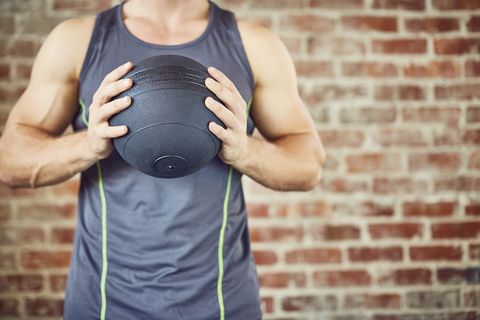

Exercises like ball slams can be a great way to get fit while blowing off some steam — but some experts think the aggro move is just a dangerous waste of time and energy.
Harley Pasternak, a celebrity trainer to the likes of Adam Levine, isn’t a fan of ball slams. In a recent Instagram post, the trainer shared a video of a woman performing the movement, only to have the ball bounce back up and smash her in the face after slamming off the floor.
There are many exercises that have become popular in the fitness world that are neither useful or safe. The ball slam is without a doubt one of them. If you love this exercise, why? #dumbexercises #exercise
A post shared by Harley Pasternak MSc (@harleypasternak) on
“There are many exercises that have become popular in the fitness world that are neither useful or safe,” he captioned the post. “The ball slam is without a doubt one of them. If you love this exercise, why? #dumbexercises”
I was surprised to see Pasternak call out the ball slam in such a harsh way. Eric Salvador, CPT, head trainer at Fhitting Room in New York City, disagrees with him. “These exercises are functional movements and great for strengthening the body as a whole,” Salvador told MensHealth.com. “Throwing/slamming and lifting things from the ground to the overhead position are common everyday movements.”
Plus, Salvador said, the exercise can build strength and power in your abdominal, core, and back muscles, while also improving hand-eye coordination and building cardiorespiratory endurance.
When I contacted Pasternak to find out more about his feelings on ball slams, he didn’t budge his stance. “I think the way that most people do the exercise… is useless,” he said. “The number one reason people exercise is to change the way they look. The ball slam is primarily a performance-based exercise, [and] while I do think it might have a place in preparing athlete performance, I can think of plenty [of] other exercises that are more useful to train the muscles involved in a safer, more focused manner.”
The main beef Pasternak has centers on how people actually do the move. “The majority of people I see who do this exercise do it with incorrect technique and often compromise the health of their lower backs and upper shoulder muscles,” he said.
Salvador admitted that those injuries typically occur when people have poor lifting mechanics and attempt to power through the slams — like when someone uses their back to lift from the ground instead of their legs.
Pasternak also took issue with the equipment used to perform a ball slam, noting that most facilities — including Fhitting Room — instruct people to use medicine balls, not slam balls made specifically for the exercise.

The main difference is that slam balls are filled with sand that shifts constantly while you train with it (making it harder to grab, hold, or throw), while medicine balls, well, don’t. Medicine balls are often made out of springy rubber composite materials, so they’re easier to bounce. You’re not necessarily working as hard, and the ball could potentially spring back up and slam you in the face if your hand-eye coordination isn’t on point.
But Salvador argues that the Dynamax medicine balls he uses for the exercise, which are softer and larger in circumference, are helpful because they can be used in a variety of movements and range from 8 to 20 lbs.

Plus, depending on how hard you slam it, the ball may or may not bounce back up — meaning you either have to squat down to pick it up, or you have to work on your hand-eye coordination to snatch it on the return. Is that potentially dangerous? If you use bad form, sure — but it’s also an opportunity to grow stronger once you can perform the exercise properly.
How to Actually Do Ball Slams Safely
So, if you’re in the pro-ball slam camp, you need to incorporate the exercise into a routine safely. First, focus on technique. Here’s how Salvador says to do a ball slam correctly:
Make sure to choose your weight wisely. The most common mistake Salvador said he sees is over-eager slammers using a ball that’s too heavy. If you’re new to the exercise, opt for a lighter weight until you’re confident your form is on point, then build back up. Start by adding 3 sets of 5 slams to your workouts, then ramp up your reps as you master the movement.

Newbies should also look for a sand-filled slam ball or a medicine ball that won’t bounce back, like this Star Wars-themed Slam Ball from Onnit, so you can work on your reaction time separately. That way you can combine the two aspects of the exercise when you feel comfortable in both arenas, without risking your face to the wrath of an overly-bouncy ball.
Source: Read Full Article